Automated Batch Job Monitoring: Ensuring ERP System Stability and Improving Business Efficiency

Why Batch Job Monitoring Is Crucial
In today’s business environment, where processes are becoming increasingly complex and interconnected, effective control of batch jobs execution in Microsoft Dynamics ERP systems is paramount.
Batch jobs perform critical operations: they update data, verify information, automate calculations, and much more.
However, as their number and complexity grow, managing batch jobs becomes more labor-intensive and fraught with a number of challenges:
- Complexity of manual control. In large organizations, the number of batch jobs can run into the hundreds or even thousands. Manual monitoring of such a volume of tasks is not only inefficient but also virtually impossible, which increases the risk of delays or missing critical errors.
Lack of real-time control. Standard mechanisms in Microsoft Dynamics do not always allow you to quickly identify deviations, such as startup delays or batch jobs exceeding their execution time. This makes it difficult to quickly respond and fix problems.
Fragmentation of data and lack of analytics. Without a centralized monitoring tool, data on the execution of batch jobs remains fragmented. This makes it difficult to analyze errors and identify recurring issues and complicates long-term planning.
Risks to business. Errors or delays in batch jobs execution can lead to business process failures, data loss, financial losses and even legal consequences.
To address these challenges, we have created [ICS] Monitoring Tool, a flexible solution for monitoring and analyzing the execution of batch jobs in Microsoft Dynamics. This tool allows you to automate the monitoring process, minimize risks and improve the stability of your Microsoft Dynamics system.
Solution Concept
Below is a generalized diagram of how [ICS] Monitoring Tool interacts with the ERP system and users:
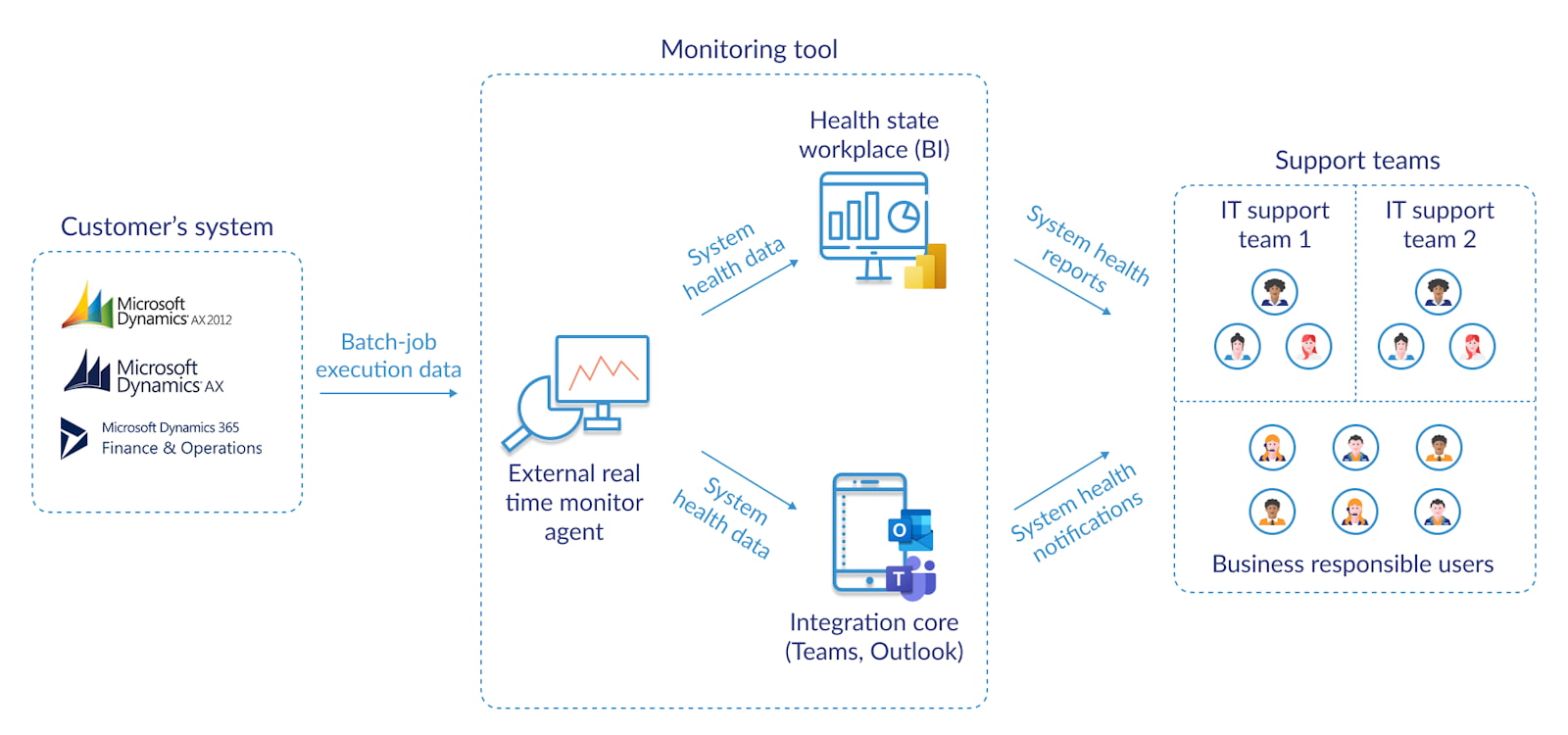
The Monitoring Tool is a comprehensive solution that consists of the following components:
- External Real-Time Monitor Agent – provides flexible control over tasks execution.
Health State Workplace (BI) – allows you to quickly analyze and visualize the current state of the system.
Integration core (Teams, Outlook) – instantly notifies support teams of critical changes.
The key component of the solution is the External Real-Time Monitor Agent. It monitors the execution of batch jobs, collects data on their execution and analyzes errors.
The processed information is transferred to the Health State Workplace (BI) based on Power BI, where engineers can monitor the system status and current issues.
The Integration core provides instant notifications to Microsoft Teams, email and mobile apps. This ensures that relevant business users and IT support teams are immediately notified of the current status of batch jobs execution and can quickly respond to active errors and changes in the system.
How Does [ICS] Monitoring Tool Work?
The image below illustrates the main stages of the Monitoring Tool’s work process:
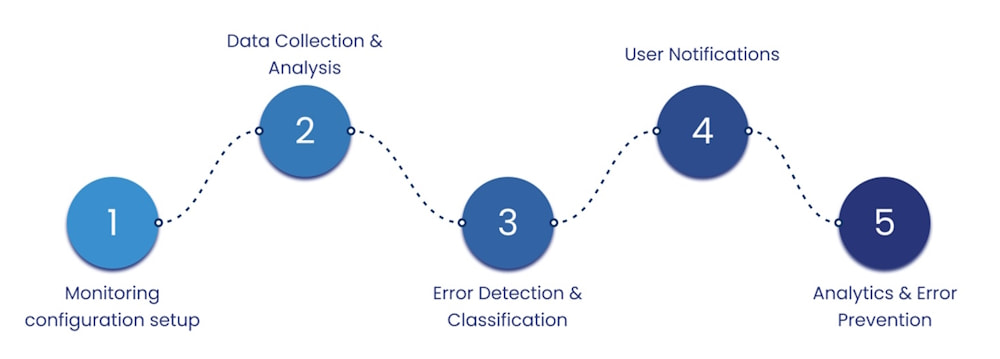
1. Monitoring configuration setup
The process starts with setting up the monitoring parameters. The user needs to complete a configuration file, which specifies information on the batch jobs to be monitored. The following parameters are set in the file:
- Batch ID
- Batch Name
- Recurrency of batch job
- Waiting Time
- Responsible Users (IT support & Business user)
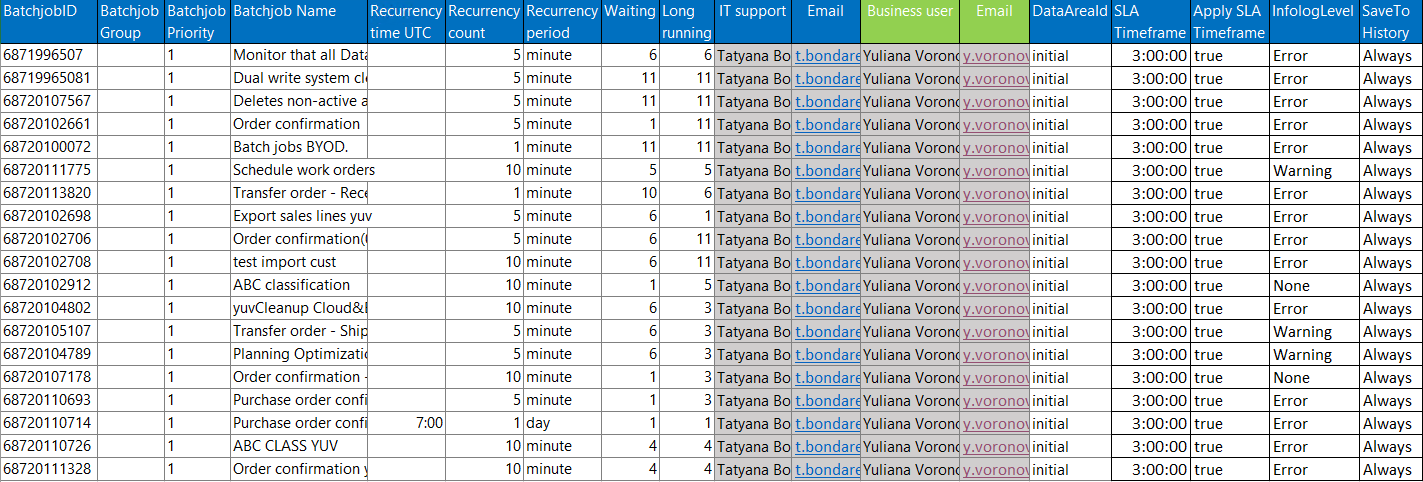
Once the configuration file is filled in, the Monitoring Tool begins monitoring the designated batch jobs, checking their execution against the specified parameters.
2. Data Collection & Analysis
The External Real-Time Monitor Agent monitors the execution of batch jobs in the Microsoft Dynamics ERP system and analyzes data on their execution, checking:
- Whether the batch job has started on time.
- Whether the execution time matches the time specified in the configuration file.
- Whether the batch job has been successfully completed.
- Whether there are any other deviations from the norm.
3. Error Detection & Classification
When a discrepancy or error is detected, the External Real-Time Monitor Agent automatically classifies it according to two key parameters: criticality and origin.
► By criticality, errors are classified as:
Critical (errors that can lead to serious consequences for business), for example:
- Batch job terminates with an error (StatusError);
- Batch job in Withhold status (StatusHold), etc.
Non-critical (errors that do not have an immediate business impact but require attention to prevent potential problems in the future), for example:
- Long wait for batch job start (WaitingError);
- Long execution of batch job (LongRunningError), etc.
► By origin, errors are divided into:
Batch Errors (batch job execution errors), for example:
- Missing batch job in the system (MissingBatch);
- Completion of batch job with errors in Infolog (InfologError), etc.
Application Errors, for example:
- Error reading the configuration file (NewSettingsReadError);
- The Monitor Tool Agent service is unavailable or not connected to the system (UnavailableServiceError), etc.
4. Instant notification of users
The Integration core ensures lightning-fast transmission of system status notifications to support teams.
Integration with Microsoft Teams, email and mobile applications is supported, allowing specialists to instantly receive notifications and promptly respond to changes in the system status.
Error notifications include error details, such as batch job data (number and name), error type, message text, and specifies responsible users (IT support & Business responsible user):
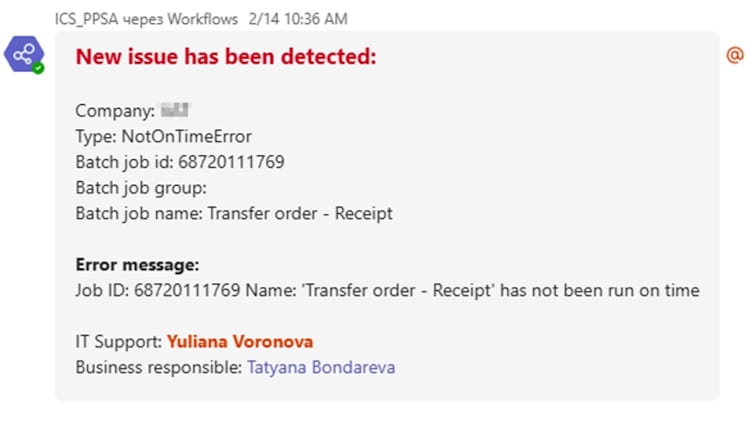
|
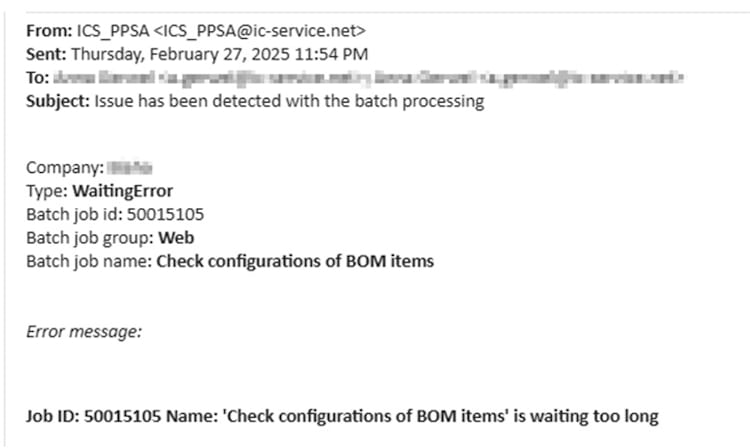
|
|---|---|
|
|
|
5. Analytics and error prevention
Health State Workplace (BI) is based on Power BI and has been developed to support engineers. It helps to monitor system status, identify problems and make informed decisions based on relevant data. This tool can be implemented across various support teams and customized to the needs of users. It works on phones, tablets, computers and large monitors.
The workspace provides two key types of information:
► Current system health state
The report includes the following information:
- General system status
- List of active errors, their occurrence and resolution times
- Table with detailed information on batch jobs (parameters, current status, number of errors, time of status change)
- History of errors with their type, registration date and resolution time
- Hyperlinks to batch jobs for quick access to their parameters in the system
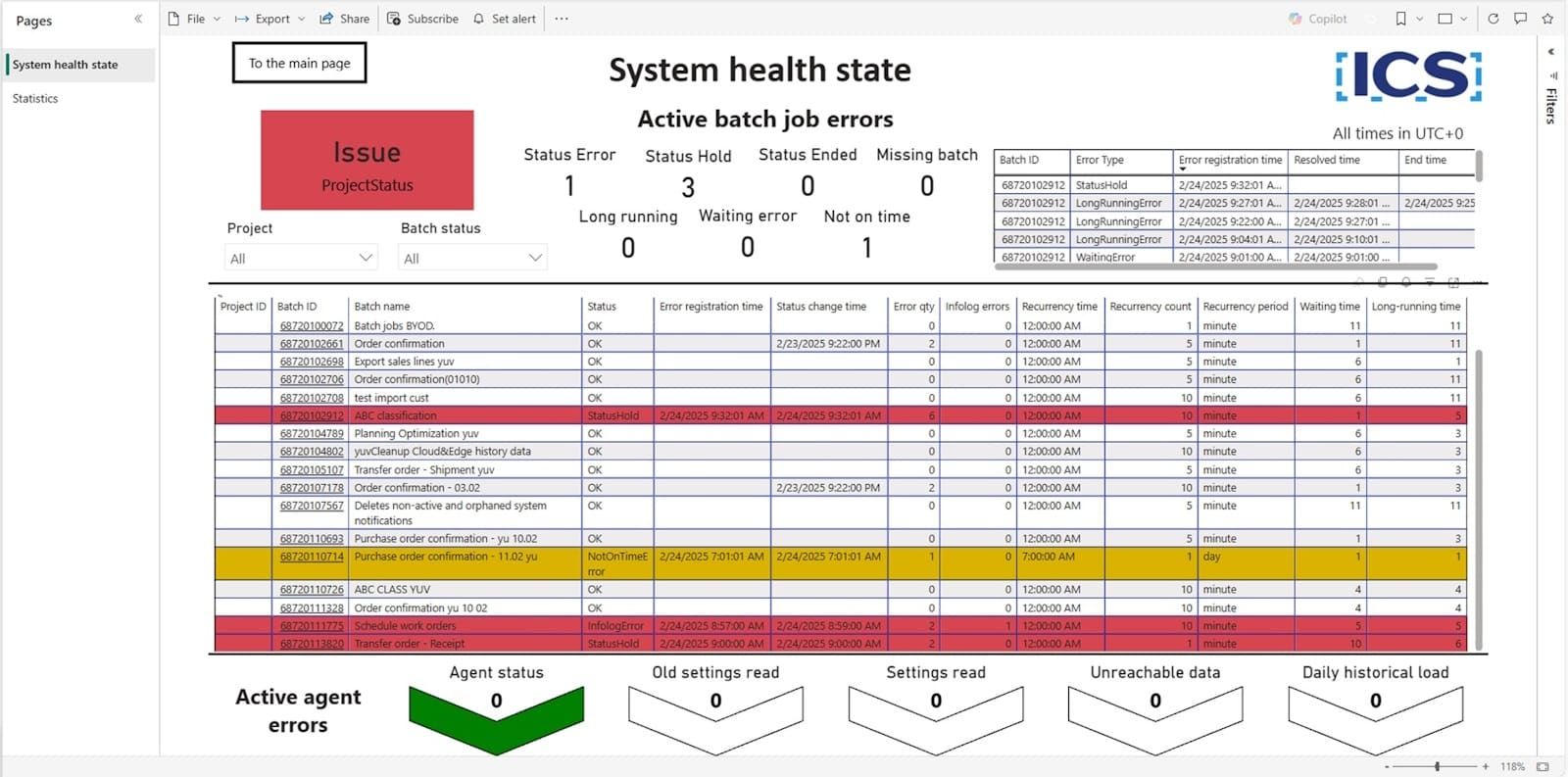
► Analytics and statistics
Allows you to analyze errors, identify trends, and predict potential problems. It provides detailed information on the number of errors over a period, the frequency of errors, the average time to resolve them, and helps identify the most vulnerable processes and the causes of their failures.
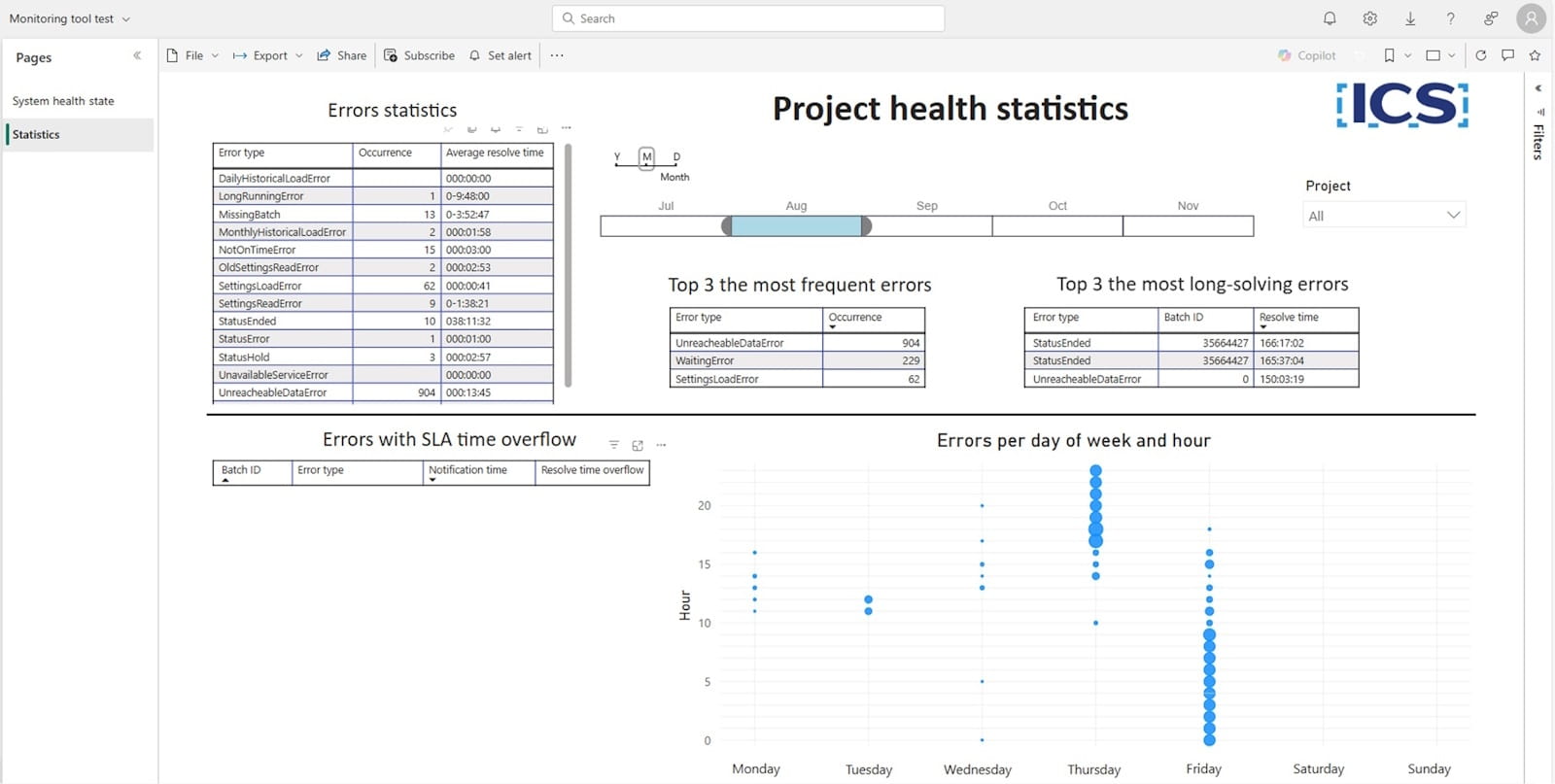
Key Benefits of [ICS] Monitoring Tool
✅ Adaptable to your business needs: service or product. The tool can be provided as a service, with full control and support from our specialists, or as a product, delivered to you with training and technical support. This allows you to choose the most suitable option depending on your business needs.
✅ Automated monitoring. The tool fully automates the process of monitoring the execution of batch jobs, eliminating the need for manual checking and reducing the risk of human error.
✅ Data collection from various versions of Microsoft Dynamics ERP. Our solution supports all versions of the Microsoft Dynamics ERP system (AX 4.0, AX 2009, AX 2012, D365 F&SCM), allowing you to monitor the execution of batch jobs in one system.
✅ Transparency and analytics. Integration with Power BI provides data transparency and the ability to analyze the performance of batch jobs, identify trends and prevent future problems.
✅ Efficiency and quick response. Instant alerts allow the support team to quickly respond to incidents, reducing downtime and minimizing risks to your business.
✅ Flexibility and customization to business needs. The tool allows you to configure monitoring parameters for each batch job, classify errors by criticality and set individual control parameters.
Benefits For Your Business
✅ Minimize system delays and costs by identifying problems quickly. Automated monitoring reduces the risk of missed errors during batch jobs execution, eliminating delays in business processes and the costs of resolving them.
✅ Improve stability of your Microsoft Dynamics ERP system. Real-time monitoring ensures system stability by preventing errors and delays.
✅ Save time and resources. Automated monitoring frees employees from routine tasks, allowing them to focus on strategic issues, and eliminates the need to involve staff in the process of resolving critical errors that occur during execution of batch jobs.
✅ Improve analytics and forecasting. By collecting and analyzing batch jobs execution data, you can identify bottlenecks in business processes, optimize processes and improve overall business efficiency.
✅ Preserve business reputation with customers and partners. Stable operation of the system and execution of batch jobs prevents production and delivery disruptions, which strengthens the trust of customers and partners.
Afterword
This article has covered the key aspects of [ICS] Monitoring Tool and its impact on the efficiency of business processes. If you would like to learn more about our Monitoring Tool and how it can benefit your business, please contact us.